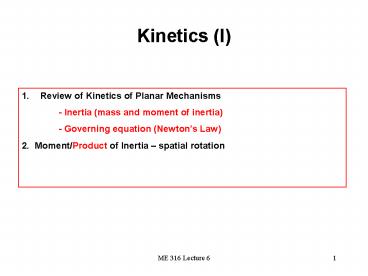Kinetics I - PowerPoint PPT Presentation
1 / 22
Title:
Kinetics I
Description:
Kinetics (I) Review of Kinetics of Planar ... Review of Planar Kinetics of a Rigid Body. Kinetics: how does a body move under the force and / or moment ? ... – PowerPoint PPT presentation
Number of Views:76
Avg rating:3.0/5.0
Title: Kinetics I
1
Kinetics (I)
- Review of Kinetics of Planar Mechanisms
- - Inertia (mass and moment of inertia)
- - Governing equation (Newtons Law)
- 2. Moment/Product of Inertia spatial rotation
2
Review of Planar Kinetics of a Rigid Body
Kinetics how does a body move under the force
and / or moment ?
2. If there is no any force or moment applied to
a body, the body will remain its current status.
This statement is called Newton First Law.
3. Force and moment are vector, and they have
direction, so the Newton First Law corresponds to
the direction.
Ex No force in horizontal direction, no motion
due to Newton First Law however, there is a
force (gravity) in vertical direction, there is
motion
3
Review of Planar Kinetics of a Rigid Body
The basic evidence to support the Newton First
Law is the inertia
- A property of the body
- A measure of how difficult or easy the motional
state of the body can be changed - An inherent resistance to change a bodys motion
state
4
Review of Planar Kinetics of a Rigid Body
Two types of inertia (depending on types of
causes) Cause is force inertia is mass (m) Cause
is moment inertia is the moment of inertia (IP)
5
Review of Planar Kinetics of a Rigid Body
Example (to be filled)
Find IA and IB
IA ? IB
6
Review of Planar Kinetics of a Rigid Body
Parallel axis theorem (to be filled)
To verify the parallel axis theorem, namely Find
IB IGml2
G is the center of gravity
7
Review of Planar Kinetics of a Rigid Body
Kinetic energy (K)
- Translation (T) (to be filled)
- Rotation (R) (to be filled)
- General (T R) (to be filled)
8
Review of Planar Kinetics of a Rigid Body
Kinetics Equation
Translation
X and Y axes may not be horizontal or vertical
rather they could be in any direction but not in
parallel. G center of gravity of a body
9
Review of Planar Kinetics of a Rigid Body
Rotation
Case 1
May not be fixed
10
Review of Planar Kinetics of a Rigid Body
P
PG (mass center)
Case 2
G
Case 3 P is fixed point
G
P
11
Review of Planar Kinetics of a Rigid Body
Translation and rotation
Case 1
Case 2
Case 3
12
Moment/product of Inertia of Spatial Rotation
13
Moment/product of Inertia of Spatial Rotation
Product of Inertia The concept of
Orthogonal planes
14
Moment/product of Inertia of Spatial Rotation
Product of Inertia (special cases)
If either one or both of the orthogonal planes
are planes of symmetry for the mass, the product
of inertia with respect to these planes will be
zero.
15
Moment/product of Inertia of Spatial Rotation
Examples of Product of Inertia (special cases)
x
16
Moment/product of Inertia of Spatial Rotation
Parallel-axis and parallel-plane theorems
17
Moment/product of Inertia of Spatial Rotation
Inertia Tensor a compact way to express to be
filled in classroom
18
Moment/product of Inertia of Spatial Rotation
Principal axes - principal moments of inertia
If the coordinate axes are oriented such that two
of the three orthogonal planes containing the
axes are planes of symmetry for the body, then
all the products of inertia for the body are zero
with respect to the coordinate planes, and hence
the coordinate axes are principal axes of inertia
19
Moment/product of Inertia of Spatial Rotation
Moment of inertia about an arbitrary axis (to be
filled in classroom
20
Moment/product of Inertia of Spatial Rotation
Example 1
The bent rod ABCD has a weight of 1.5 lb/ft
Find the location of center of gravity G and
Ix, Iy, Iz
21
Moment/product of Inertia of Spatial Rotation
Example 2
The 1.5 Kg rod and 4 Kg disk
Find Iz of the composite body
22
Moment/product of Inertia of Spatial Rotation
Example 3
The bent rod OABC has mass of 4 Kg/m
Find Ixx of the rod































